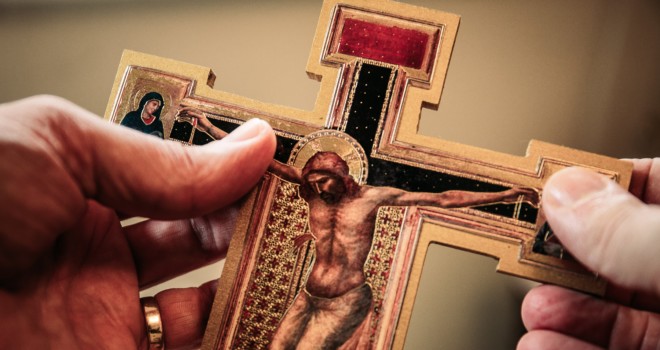We have to accustom ourselves to pray in all places as at all times. The real place to pray in is the soul, for God dwells there. If we wish to obey our Lord’s counsel, when we pray we should enter the chamber of our soul, close the door, and speak to the Father, whose loving eyes seek ever our own. This inner chamber of our soul is the true temple, the sacred sanctuary, and we carry it with us and can at any time either remain there or quickly return to it, should we have been obliged to leave it.
And we must make it a really spotless and beautiful place. Its true beauty, of course, is our Lord’s presence. In it He should be able to feel at home, and He is at home if He sees His own features there. These features are His perfections, and when they are reflected in the soul, they are called virtues. The soul that possesses them is beautiful with His beauty; it is perfect “as our heavenly Father is perfect.” The as here does not mean “as much”; it does not imply equality but resemblance.
By the virtues we are reformed in God’s image, and in the image of His divine Son, who came to reveal His Father’s features to us, by practicing the virtues.
In this reserved sanctuary — a new heaven and kingdom of God — solitude and silence must reign. God is alone with Himself. The divine Persons do not affect this solitude; they constitute it. The Love who is their animating force encloses them against all that is not Himself. The City of God is immense, but enclosed. God alone occupies it, and He is All in all.
The soul that prays must reproduce this solitude; it must be filled by it to the exclusion of all else. The very colloquy that follows is a kind of silence.
Speech and silence are not opposed; they do not exclude one another. What is opposed to silence is not speech but words — that is, multiplicity. We confuse the silence of being with the silence of “nothingness,” which knows neither how to speak nor how to be silent. All that it can do is to become agitated, and then it dissembles. And it does this by its superficial movements reflecting the nothingness within it.
And that is why it is garrulous. It says little in many words; or it uses words that do not say what it thinks. God needed only one Word to express Himself fully, and it is toward that unity (of the Word) that we tend when we are alone with God. He has become all, and we tell Him so — what more can we say?
It is the silence of the soul recollected in itself and occupied with Him whom it finds there. It is the silence of those long nights that Jesus passed on the mountainside during His prayer to God. It was the silence of Gethsemane or of Calvary, broken only by a few words for us.
Churches are places for prayer in common. They must reproduce God’s features and those of souls that need the body to express themselves. They must offer to the body lines that run upward toward Heaven or fade away in the mystery of a semidarkness.
They must isolate the building from the world and its noises, and form a central point around which everything tends to draw the soul’s powers, to concentrate and unify them and evoke our love. They must reveal beauties that are altogether beyond us; they must give us a peace that does not come from created things but draws us above them. They must create a great harmony of the natural and the supernatural, in which He who has made both matter and spirit is revealed. His presence shines through, and His love draws us. We must breathe Him through the very pores of our being, just as we breathe the air. A place of worship that does not evoke this response, and the soul that, on entering it, does not respond to that appeal are not true to themselves and deceive others.
Enter your inner chamber
God is a brazier of love. Prayer brings us near to Him, and in coming near to Him, we are caught by His fire. The soul is raised by the action of this fire, which is a kind of spiritual breath that spiritualizes it and carries it away. The soul frees itself from all that weighs it down, keeping it attached to this wearisome earth. The psalmist compares this breath to incense. Now, incense is a symbol universally known and exceptionally rich. But from all the substances that fire penetrates under the form of flame or heat, there follows a movement by which it spreads, causing it to increase by communicating itself to all that surrounds it.
The movement of the soul that prays has something
special about it. It goes out from itself and yet remains in itself. It passes
from its natural state to its supernatural state; from itself in itself to
itself in God. At first glance, these expressions may seem strange. The mystery
is not in the realities but in our understanding of them. Our mind is not used
to these realities; we have to become accustomed to them.
Our soul is a dwelling with many apartments. In the
first, it is there with the body; that is to say, with all the body’s
sensitiveness.
It sees when the eye sees, hears when the ear hears. It
moves with the muscles; it remembers, imagines, and appreciates distances, when
we take part in all the activities that are the common ground of its action
with the body. In the second, the soul is alone and acts alone. The body is
there — it is always there — but it no longer acts; it has no part in the
soul’s action. The soul alone thinks and loves. The body with its senses
prepares the matter and elements, the conditions of this spiritual activity,
but it has no part in producing it. That room is closed; the soul is there
alone and dwells there alone.
In that spiritual dwelling there is a part still more remote. It is the dwelling-place of being, who communicates Himself and makes us to “be.” We are so accustomed to live turned outward (and objects of sense keep us so turned), we hardly ever open the door of that chamber, and scarcely give it a glance; many die without ever suspecting its existence. Men ask, “Where is God?” God is there — in the depths of their being — and He is there communicating being to them. They are not HIM WHO IS and who gives being to all other things. They receive being; they receive a part of being that does not depend upon themselves. They receive it for a certain time and under certain forms. And from His “beyond” God gives them existence. They exist only by His power and are only what He enables them to be. He is at the source of all they do and, no matter how much they may desire to continue those activities, they cannot do so if He is not there. To understand this, we have to think a great deal, and reflection — perhaps the highest form human act can take — has given place to exterior action and to local movement, both of which are common to animals and matter.
The soul that prays enters into this upper room. It places itself in the presence of that Being who gives Himself, and it enters into communication with Him. To communicate means to have something in common and, by this common element, to be made one. We touch, we speak, we open out to one another. Without this “something,” we remain at a distance; we do not “communicate.” God is love. We enter into communication with Him when we love, and in the measure of our love. The soul that loves and that has been introduced by Love into that dwelling-place where Love abides can speak to Him. Prayer is that colloquy. God will not resist that love which asks. He has promised to do the will of those who do His will.
It is to love that is due these divine communications which have drawn from those happy recipients the most amazing exclamations. “Lord, stay, I beg you, the torrent of your love. I can bear no more.” The soul, submerged and ravished, has fainted under the weight of these great waters and has asked to be allowed to take breath for an instant, in order the better to renew its welcome. The anchorite in the desert, when he prayed, had to forbear extending his arms, so as not to be rapt in his prayer. St. Mary the Egyptian, St. Francis of Assisi, were raised up from the ground and remained upheld by a power greater than the weight of their body.
✠
This article is from a chapter in Dom Guillerand’s The Prayer of the Presence of God. It is available from Sophia Institute Press.
Photo by James Coleman on Unsplash











